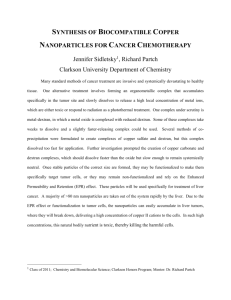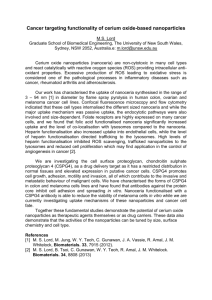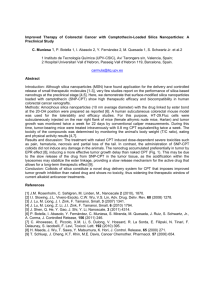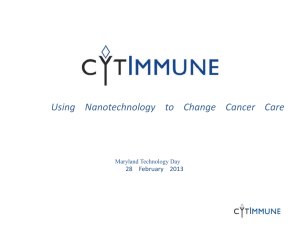Nanomedicine Becomes Personal: Multifunctional Nanoparticles for
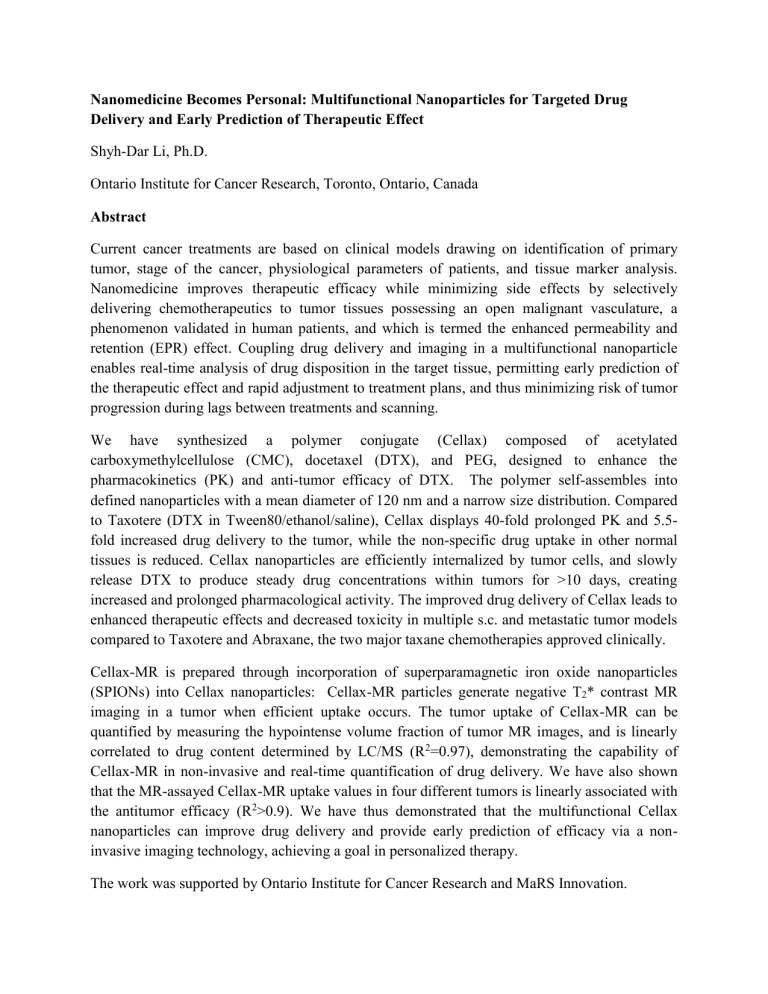
Nanomedicine Becomes Personal: Multifunctional Nanoparticles for Targeted Drug
Delivery and Early Prediction of Therapeutic Effect
Shyh-Dar Li, Ph.D.
Ontario Institute for Cancer Research, Toronto, Ontario, Canada
Abstract
Current cancer treatments are based on clinical models drawing on identification of primary tumor, stage of the cancer, physiological parameters of patients, and tissue marker analysis.
Nanomedicine improves therapeutic efficacy while minimizing side effects by selectively delivering chemotherapeutics to tumor tissues possessing an open malignant vasculature, a phenomenon validated in human patients, and which is termed the enhanced permeability and retention (EPR) effect. Coupling drug delivery and imaging in a multifunctional nanoparticle enables real-time analysis of drug disposition in the target tissue, permitting early prediction of the therapeutic effect and rapid adjustment to treatment plans, and thus minimizing risk of tumor progression during lags between treatments and scanning.
We have synthesized a polymer conjugate (Cellax) composed of acetylated carboxymethylcellulose (CMC), docetaxel (DTX), and PEG, designed to enhance the pharmacokinetics (PK) and anti-tumor efficacy of DTX. The polymer self-assembles into defined nanoparticles with a mean diameter of 120 nm and a narrow size distribution. Compared to Taxotere (DTX in Tween80/ethanol/saline), Cellax displays 40-fold prolonged PK and 5.5fold increased drug delivery to the tumor, while the non-specific drug uptake in other normal tissues is reduced. Cellax nanoparticles are efficiently internalized by tumor cells, and slowly release DTX to produce steady drug concentrations within tumors for >10 days, creating increased and prolonged pharmacological activity. The improved drug delivery of Cellax leads to enhanced therapeutic effects and decreased toxicity in multiple s.c. and metastatic tumor models compared to Taxotere and Abraxane, the two major taxane chemotherapies approved clinically.
Cellax-MR is prepared through incorporation of superparamagnetic iron oxide nanoparticles
(SPIONs) into Cellax nanoparticles: Cellax-MR particles generate negative T
2
* contrast MR imaging in a tumor when efficient uptake occurs. The tumor uptake of Cellax-MR can be quantified by measuring the hypointense volume fraction of tumor MR images, and is linearly correlated to drug content determined by LC/MS (R
2
=0.97), demonstrating the capability of
Cellax-MR in non-invasive and real-time quantification of drug delivery. We have also shown that the MR-assayed Cellax-MR uptake values in four different tumors is linearly associated with the antitumor efficacy (R
2
>0.9). We have thus demonstrated that the multifunctional Cellax nanoparticles can improve drug delivery and provide early prediction of efficacy via a noninvasive imaging technology, achieving a goal in personalized therapy.
The work was supported by Ontario Institute for Cancer Research and MaRS Innovation.

